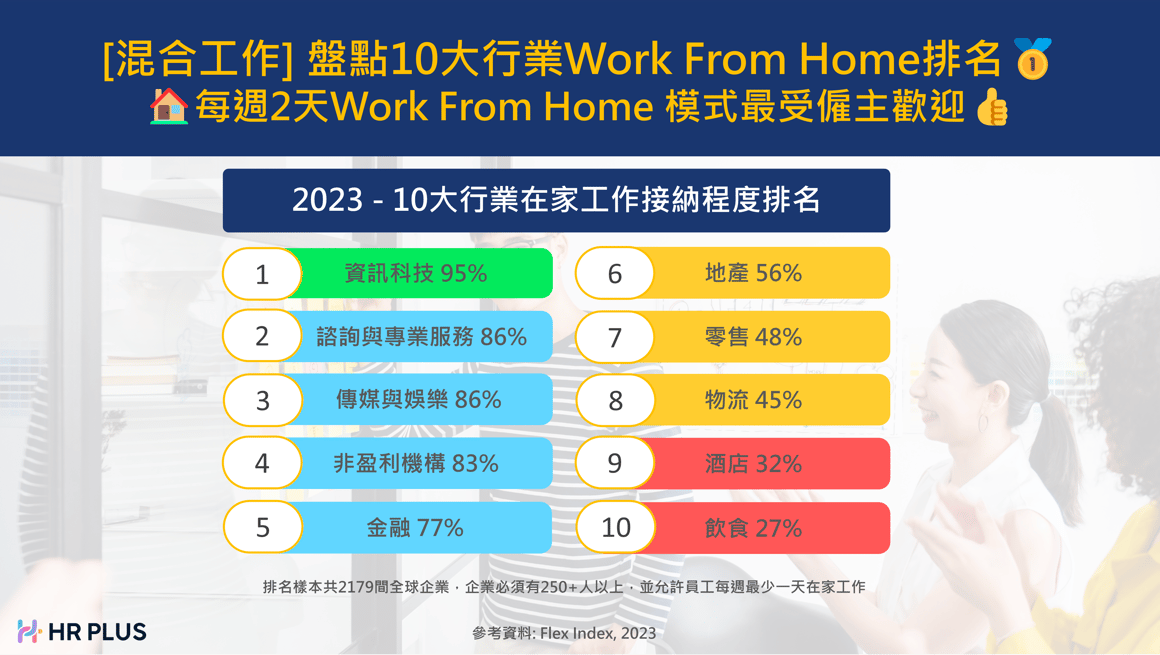[混合工作] 盤點 2023 十大行業Work From Home排名🥇

在疫後的就業市場中,靈活性經已成為求職者的首要搵工條件,越來越多求職者優先考慮在家工作,以求得更好的生活平衡及工作自主。在本文中,我們將盤點10大行業中,哪一行最多採取在家工作安排,並探索市場上最受歡迎的混合工作模式。
行業混合工作接納度排名:
在10大行業中,科技行業無庸置疑為行業領先,有95%的公司採用混合工作,其次是專業服務(86%)和金融(77%)。而房地產(56%)、零售(48%)和供應鏈(45%)表現出中等的適應能力,而酒店(32%)和飲食業(27%)由於業務性質的原因表現依然落後。
|
2023 行業混合工作接納度排名 企業必須有250+人以上,並允許員工每週最少一天在家工作 |
||
| 1 | 資訊科技 | 95% |
| 2 | 諮詢與專業服務 | 86% |
| 3 | 傳媒與娛樂 | 86% |
| 4 | 非盈利機構 | 83% |
| 5 | 金融 | 77% |
| 6 | 地產 | 56% |
| 7 | 零售 | 48% |
| 8 | 物流 | 45% |
| 9 | 酒店 | 32% |
| 10 | 飲食 | 27% |
最受歡迎的混合工作模式:
在混合工作模式中,最受僱主歡迎的是「最低工作日」(30%)和「員工自選」(21%)。這種趨勢表明大多僱主並不堅持5天辦公室工作或支持全面遠程工作,而有意取之中庸,在工作靈活性與工作文化之間取得平衡。
| 以靈活性政策分類的工作模式 | |
| 5天辦公室工作 | 42% |
| 最低工作日 | 30% |
| 員工自選 | 21% |
| 全面遠程工作 | 7% |
最多公司採用的混合工作安排:
「最低工作日」允許員工在家工作一定的天數,並在其餘日子返回辦公室。平均而言,僱主允許員工每週在家工作約2.53天。而公司通常要求員工每週回辦公室三天(50%)或兩天(41%),其中星期二(78%)、星期三(69%)和星期四(58%)通常需要員工強制返回辦公室工作。
公司規模與混合工作:
500人以下的小型公司(63%)大多採用全面靈活的混合工作模式。500-5000人的中型公司則呈現分歧,45%堅持每週5天辦公室的模式,55%採取混合模式。而5000+人以上的大型企業(66%)主要傾向於結構化的混合模式,即要求員工每週至少在辦公室工作一定的天數。
混合工作新常態
隨著混合工作模式重塑就業市場,雇主必須考慮轉變傳統的工作設計和行業實踐,並透過自動化和增加靈活性實現混合工作。那些未能採取混合工作的企業,將在當今競爭激烈的人才戰中漸落下風。是時候擁抱混合工作所帶來的機遇,並保持領先,以建立具有彈性的工作模式。
___________________________________________________________________________________________________________________
🌟 Counting the Top 10 Industries with Hybrid work Practices in 2023🥇
Flexibility has become a game-changer in today's job market, with job seekers increasingly prioritizing the option to work from home for a better work-life balance and autonomy. In this article, we'll uncover the industries leading the charge in adopting hybrid work practices and explore the most popular models in the market.
Industry Flexibility Rankings:
The tech industry leads with an impressive 95% of companies offering remote work, followed closely by professional services (86%) and finance (77%). While real estate (56%), retail (48%), and supply chain (45%) show moderate adaptability, the hospitality (32%) and food & beverage (27%) sectors are still catching up due to the nature of their operations.
|
2023 Industry Flexibility Rankings: Companies with 250+ headcount and allow at least 1-day work from home per week |
||
| 1 | Tech | 95% |
| 2 | Professional Services | 86% |
| 3 | Media & Entertainment | 86% |
| 4 | Non-Profit | 83% |
| 5 | Finance | 77% |
| 6 | Real Estate | 56% |
| 7 | Retail | 48% |
| 8 | Logistic | 45% |
| 9 | Hospitality | 32% |
| 10 | Food & Beverage | 27% |
Most Popular Hybrid Work Models:
In the dynamic landscape of hybrid work models, the Minimum Day/Time Model (30%) and Employee Choice Model (21%) take center stage as the most favored practices among companies. This trend indicates a growing emphasis on striking a balance between flexibility and maintaining a productive work culture.
| Work Model Adoption by Office Requirement | |
| 5 Days Work in Office | 42% |
| Minimum Day/Time Model | 30% |
| Employee Choice Model | 21% |
| Fully Flexible | 7% |
Most Adopted Hybrid Work Arrangement
The Minimum Day hybrid work model allows employees to work from home for a set number of days, with a minimum number of office days required. On average, employees work remotely for approximately 2.53 days per week. Companies often require employees to return to the office for three days (50%) or two days (41%) each week, with Tuesday (78%), Wednesday (69%), and Thursday (58%) being the most popular in-office days.
Hybrid Work Practices by Company Size:
Small companies (63%) prioritize full flexibility, allowing employees to choose when and where they work. Medium-sized companies show a split, with 45% sticking to the 5-day office week and 55% adopting a hybrid approach. Larger companies (66%) predominantly prefer a structured hybrid model, mandating a minimum number of office days each week.
Conclusion: Embrace the New Norm of Hybrid Work
As hybrid work practices reshape the modern workplace, employers must proactively transform their industry practices and job design. Embracing automation and increasing flexibility are crucial steps towards adopting the new norm of the hybrid work model. The future belongs to agile and adaptable workforces, and companies that fail to embrace these changes will face disadvantages in attracting and retaining talent in today's competitive job market. It's time to embrace the opportunities that hybrid work presents and stay ahead of the curve for a thriving and resilient workforce.
